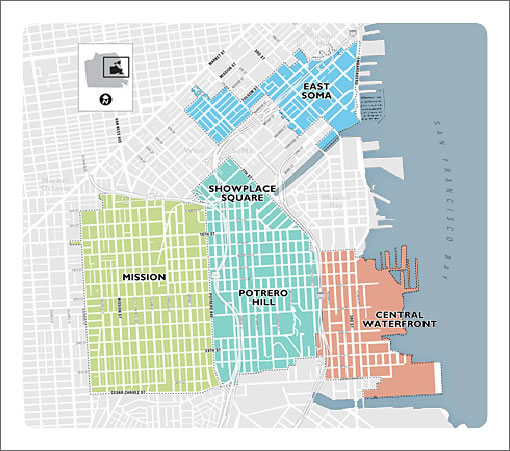
Over the past twenty-two years, well over $116 million in development impact fees have been collected from developers in San Francisco which doesn’t include the value of 1,013 units of on-site below market rate (BMR) housing built over the past eight.
Over the next five years, the Planning Department is projecting over $45 million in impact fees will be collected with the largest contributions coming from the following areas: Balboa Park ($2.7 million), Rincon Hill ($6 million), Market and Octavia ($12 million), and $25 million from and for the Eastern Neighborhoods (which includes the Central Waterfront, East SOMA, Showplace Square/Potrero, and the Mission).
If you’re interested in the details in terms of what the fees are, where the fees have been collected, on what the fees are earmarked to be spent, and who is planning on doing the spending, be sure to review the 2009-2010 Development Impact Fee Report which will be presented to San Francisco’s Planning Commission tomorrow.
∙ Eastern Neighborhoods Plan, It’s Not Just For Policy Wonks Anymore [SocketSite]
∙ Development Impact Fee Anuual Report: 2009-2010 [sfplanning.org]

As usual, western SOMA residential enclaves get all the impacts of the MO plan (traffic, shadows from monster buildings on the south side of Mission and South Van Ness, noise and air pollution) and zero benefit.
@Western Soma: that’s not actually true. From the Report referenced in the post:
“Additionally the IPIC provides a forum for ongoing planning work in current planning efforts including Japantown6 and Western SOMA.7 As these planning processes progress, the IPIC will work to coordinate on infrastructure and capital planning.”
The dev fees collected by those areas do go to western soma as well.
If you dig into the document, you’ll notice Planning Code section 427, where per square foot variance fees for wanting to do anything along the lines of adaptive reuse with YOUR BUILDING jumps from $10-15 a square foot to $327 a square foot. Essentially the value of the building itself in this area.
Not a peep about this in the media.
Not yet.
Absolute whiney BS from “Western Soma.” Traffic? Um, no. Who in the hell wants to drive through Western SoMa and get shot or surrounded by homeless?!?! Shadows? Perhaps from the subsidized housing at Trinity. Otherwise, no. Western SoMa is relative low-rise and heroin needlefilled — but then that’s how you want to keep it, right? Otherwise it’s gentrification, which to you is bad, unless you get a free house. Noise? We already established that the traffic is no worse than it’s even been. Air pollution? Again, bogus, tell it to Woodsy Owl. Yet, all your shrill claims aside, the Western SoMa gets an inordinate amount of funds from taxpayers in Eastern SoMa and elsewhere.
its unlikely that these fees will be collected at published levels.
“If you dig into the document, you’ll notice Planning Code section 427, where per square foot variance fees for wanting to do anything along the lines of adaptive reuse with YOUR BUILDING jumps from $10-15 a square foot to $327 a square foot.”
Stucco-sux, where did you see the above you refer to?
If you dig into the document, you’ll notice Planning Code section 427, where per square foot variance fees for wanting to do anything along the lines of adaptive reuse with YOUR BUILDING jumps from $10-15 a square foot to $327 a square foot. Essentially the value of the building itself in this area.
It looks like that rule relates to residential open space which are primarily things like landscaping, pool areas, and common decks. Such areas may not actually be inside, though the rule might apply to patios. What exactly qualifies as residential open space and is required can vary depending on the particulars of the situation.